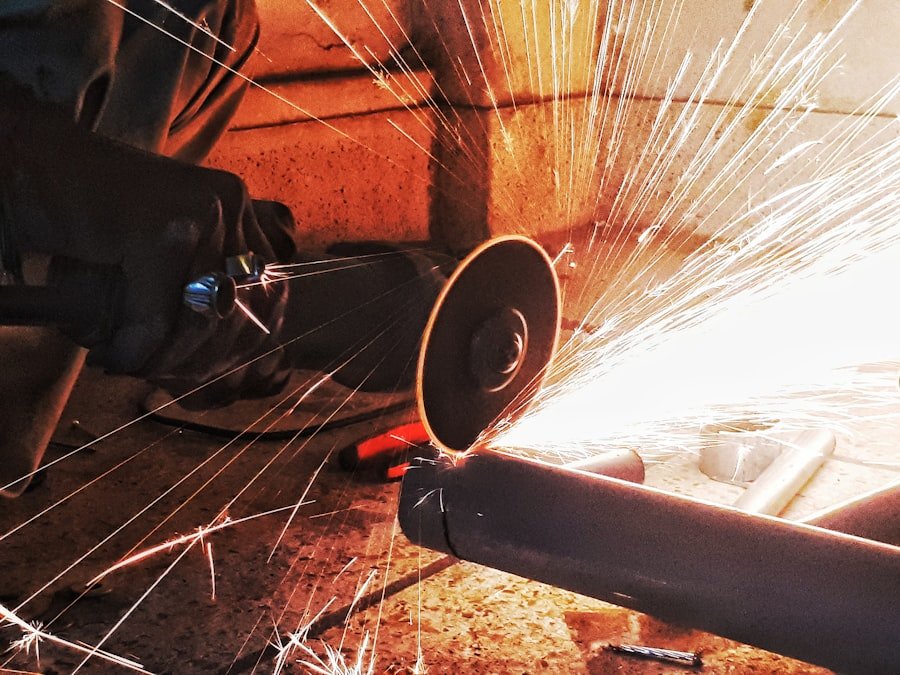Metal cutting tools are essential equipment used in various industries such as manufacturing, construction, automotive, and aerospace. These tools are designed to cut, shape, and remove metal materials to create precise and accurate components for different applications. Metal cutting tools come in a wide range of types and sizes, each designed for specific cutting tasks and materials.
From simple hand tools like hacksaws and files to advanced power tools like drills, lathes, and milling machines, metal cutting tools play a crucial role in the production and fabrication of metal parts and products. Metal cutting tools are made from high-quality materials such as high-speed steel (HSS), carbide, and cobalt, which are known for their durability and resistance to heat and wear. These tools are engineered to withstand the high forces and temperatures generated during the cutting process, ensuring long-lasting performance and precision.
Whether you are a professional machinist, metal fabricator, or DIY enthusiast, having the right metal cutting tools is essential for achieving accurate and efficient results in your projects.
Key Takeaways
- Metal cutting tools are essential for shaping and forming metal materials in various industries.
- Common types of metal cutting tools include drills, saws, lathe tools, milling cutters, and grinding wheels.
- Using the right metal cutting tools is crucial for achieving precision, efficiency, and safety in metalworking processes.
- Safety tips for using metal cutting tools include wearing appropriate protective gear, inspecting tools before use, and following proper operating procedures.
- When choosing metal cutting tools for a project, factors to consider include material type, cutting speed, tool geometry, and budget.
- Maintenance and care of metal cutting tools involve regular cleaning, sharpening, and proper storage to prolong their lifespan and performance.
- Top brands and suppliers of metal cutting tools include Bosch, DeWalt, Makita, and Sandvik Coromant, offering a wide range of high-quality tools for various metalworking needs.
Types of Metal Cutting Tools
Types of Metal Cutting Tools
Saws are used for cutting through metal sheets, pipes, and bars, and they come in different forms such as hacksaws, bandsaws, and circular saws. Drills are used for creating holes in metal surfaces and come in various sizes and designs to accommodate different drilling needs.
Shaping and Finishing Tools
Milling cutters are used for shaping and finishing metal surfaces through rotary cutting motions, while lathe tools are used for turning and shaping cylindrical metal workpieces.
Abrasive Tools
Grinding wheels are abrasive tools used for removing material from metal surfaces through grinding and smoothing actions.
Choosing the Right Tool
Each type of metal cutting tool has its own unique features and capabilities, making it suitable for specific cutting tasks and materials. Understanding the different types of metal cutting tools and their applications is essential for choosing the right tool for your project.
The Importance of Using the Right Metal Cutting Tools

Using the right metal cutting tools is crucial for achieving accurate and efficient results in metalworking projects. The use of improper or inadequate tools can lead to poor quality cuts, damaged workpieces, and safety hazards. By using the right metal cutting tools, you can ensure precise cuts, smooth finishes, and reduced material waste, ultimately saving time and resources in your projects.
Additionally, using the right tools can help prolong the lifespan of your equipment and minimize the risk of accidents and injuries in the workplace. Furthermore, using the right metal cutting tools can improve productivity and workflow efficiency by reducing downtime and rework. With the right tools at your disposal, you can tackle a wide range of cutting tasks with confidence and precision, leading to better overall project outcomes.
Whether you are working on a small-scale DIY project or a large-scale industrial production, investing in high-quality metal cutting tools is essential for achieving consistent and reliable results.
Safety Tips for Using Metal Cutting Tools
| Tool | Safety Tip |
|---|---|
| Metal Cutting Saw | Always wear safety goggles and gloves when operating the saw. |
| Angle Grinder | Ensure the workpiece is securely clamped before using the grinder. |
| Chop Saw | Keep hands and fingers away from the cutting area and use a push stick if necessary. |
| Tin Snips | Use the appropriate snips for the material being cut and always cut away from your body. |
When using metal cutting tools, it is important to prioritize safety to prevent accidents and injuries in the workplace. Here are some essential safety tips to keep in mind when using metal cutting tools: 1. Wear appropriate personal protective equipment (PPE) such as safety goggles, gloves, ear protection, and a dust mask to protect yourself from flying debris, noise, and airborne particles.
2.
Ensure that the work area is well-ventilated to prevent the buildup of fumes and dust generated during the cutting process.
3. Always follow the manufacturer’s instructions and guidelines for operating the metal cutting tools safely and effectively.
4. Keep your work area clean and organized to minimize tripping hazards and ensure proper tool storage.
5.
Use clamps or vices to secure the workpiece firmly in place before cutting to prevent it from moving or slipping during the operation.
6. Avoid wearing loose clothing or jewelry that could get caught in the moving parts of the cutting tools.
7. Regularly inspect your metal cutting tools for any signs of damage or wear and tear, and replace or repair them as needed to maintain their performance and safety.
By following these safety tips, you can minimize the risk of accidents and injuries when using metal cutting tools and create a safe working environment for yourself and others.
How to Choose the Right Metal Cutting Tools for Your Project
Choosing the right metal cutting tools for your project is essential for achieving precise cuts and efficient results. Here are some factors to consider when selecting metal cutting tools: 1. Material: Consider the type of metal material you will be working with, as different metals require specific cutting tools designed to handle their hardness, toughness, and other properties.
2.
Cutting Task: Determine the specific cutting tasks you need to perform, such as sawing, drilling, milling, turning, or grinding, and choose the appropriate tool for each task.
3. Size and Capacity: Select metal cutting tools that are suitable for the size and thickness of the workpieces you will be working with, ensuring that they have the capacity to handle your project requirements.
4. Precision and Accuracy: Look for metal cutting tools that offer precise control and accuracy to achieve clean cuts and smooth finishes on your workpieces.
5.
Durability: Invest in high-quality metal cutting tools made from durable materials that can withstand the rigors of metalworking operations and provide long-lasting performance.
6. Compatibility: Ensure that the metal cutting tools you choose are compatible with your existing equipment and machinery to facilitate seamless integration into your workflow. By considering these factors, you can make informed decisions when choosing the right metal cutting tools for your project, ultimately leading to better outcomes and productivity.
Maintenance and Care of Metal Cutting Tools

Proper maintenance and care of metal cutting tools are essential for ensuring their longevity, performance, and safety. Here are some tips for maintaining and caring for your metal cutting tools: 1. Regular Cleaning: Clean your metal cutting tools after each use to remove debris, chips, and residues that can affect their performance and precision.
2.
Lubrication: Apply lubricants or cutting fluids as recommended by the manufacturer to reduce friction, heat buildup, and tool wear during cutting operations.
3. Sharpening: Keep your cutting edges sharp by regularly sharpening or regrinding them to maintain their cutting efficiency and accuracy.
4. Storage: Store your metal cutting tools in a clean, dry environment away from moisture, dust, and extreme temperatures to prevent corrosion and damage.
5.
Inspection: Periodically inspect your metal cutting tools for signs of wear, damage, or misalignment, and address any issues promptly to prevent further deterioration.
6. Calibration: Calibrate your metal cutting tools as needed to ensure their accuracy and consistency in producing precise cuts. By following these maintenance practices, you can prolong the lifespan of your metal cutting tools, optimize their performance, and ensure safe operation in your projects.
Top Brands and Suppliers of Metal Cutting Tools
When it comes to purchasing metal cutting tools, there are several top brands and suppliers known for their quality products and reliable services. Some of the leading brands in the industry include Bosch, DeWalt, Makita, Milwaukee Tool, Hilti, Festool, Hitachi Power Tools, Stanley Black & Decker, and Snap-on Incorporated. These brands offer a wide range of metal cutting tools such as saws, drills, grinders, lathes, milling machines, and accessories designed for professional use in various industries.
In addition to these brands, there are also reputable suppliers and distributors that offer a comprehensive selection of metal cutting tools from different manufacturers. Some of the top suppliers include MSC Industrial Supply Co., Grainger Industrial Supply, Fastenal Company, McMaster-Carr Supply Company, Global Industrial Company, and Industrial Metal Supply Company. These suppliers provide a diverse range of metal cutting tools along with expert advice, technical support, and customer service to meet the needs of professionals and businesses in the metalworking industry.
Whether you are looking for high-performance power tools or precision hand tools for your metalworking projects, these top brands and suppliers offer a wide variety of options to choose from, ensuring that you can find the right metal cutting tools for your specific requirements. In conclusion, metal cutting tools are indispensable equipment used in various industries for shaping, forming, and removing metal materials to create precise components for different applications. Understanding the different types of metal cutting tools available along with their applications is essential for choosing the right tool for your project.
Using the right metal cutting tools is crucial for achieving accurate results while prioritizing safety is important when using these tools. By following proper maintenance practices and choosing from top brands and suppliers in the industry, you can ensure that you have reliable metal cutting tools that meet your project needs while maintaining safety standards in your workplace.
If you’re interested in learning more about metalworking, you might want to check out this article about the preparations and highlights of the 66th Grammy Awards at Crypto.com Arena. It’s always fascinating to see the behind-the-scenes work that goes into creating a spectacular event, and it can provide insight into the tools and techniques used in metalworking as well.
FAQs
What are the different types of tools used to cut metal?
There are several types of tools used to cut metal, including hacksaws, angle grinders, plasma cutters, oxy-fuel torches, and metal cutting bandsaws.
What is a hacksaw and how is it used to cut metal?
A hacksaw is a hand tool with a fine-toothed blade used to cut metal. It is operated by hand and the blade is tensioned in a frame. The user applies force to the handle and moves the blade back and forth to cut through the metal.
What is an angle grinder and how is it used to cut metal?
An angle grinder is a power tool with a rotating abrasive disc used to cut, grind, and polish metal. To cut metal with an angle grinder, a metal cutting disc is attached to the tool and the user guides the disc along the metal to make the cut.
What is a plasma cutter and how is it used to cut metal?
A plasma cutter is a tool that uses a high-velocity jet of ionized gas to cut through metal. The cutter creates an electrical channel of ionized gas (plasma) through the metal, and the metal is melted and blown away by the plasma jet.
What is an oxy-fuel torch and how is it used to cut metal?
An oxy-fuel torch is a tool that uses a mixture of oxygen and a fuel gas (such as acetylene) to create a high-temperature flame for cutting metal. The torch heats the metal to its kindling temperature and a stream of oxygen is used to blow away the molten metal.
What is a metal cutting bandsaw and how is it used to cut metal?
A metal cutting bandsaw is a power tool with a continuous band of toothed metal stretched between two or more wheels. The metal is fed into the blade and the bandsaw cuts through the metal as the blade moves in a continuous loop.




















+ There are no comments
Add yours